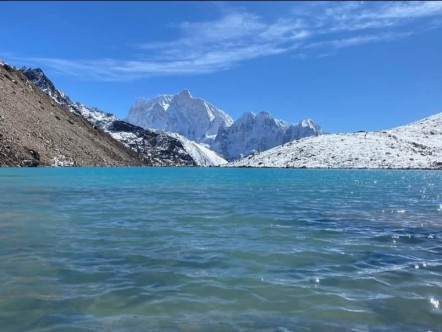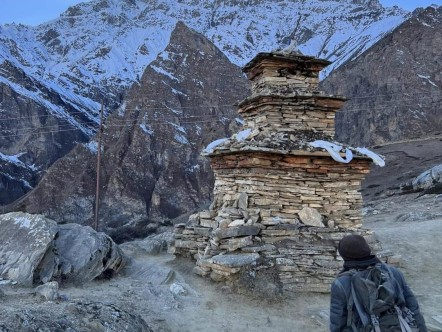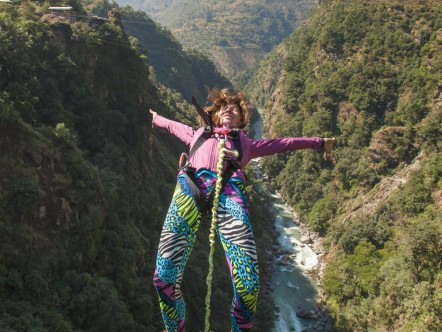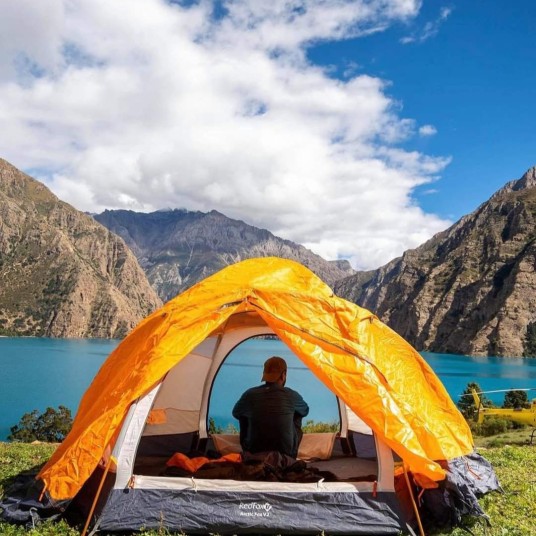Lower Dolpo Trekking
OVERVIEW
19 Days
Trekking & Hiking
2-80
Private Jeep/Tourist Bus / Flight
Hotel , Lodge & Tea House
Lower Dolpo Trek is a remote and off-the-beaten-path adventure that takes you through the pristine landscapes of Dolpo, one of the most remote regions in Nepal. This trek offers a glimpse into the traditional Tibetan culture, breathtaking scenery, and encounters with the indigenous people who call this region home.
Lower Dolpo Trek is a mesmerizing trekking destination in Nepal, known for its remote and untouched natural beauty. Nestled in the northwestern part of Nepal, Lower Dolpo Trek is a hidden gem waiting to be discovered by avid trekkers and adventure enthusiasts. This remote region offers a unique blend of natural beauty, cultural richness, and challenging terrain, making it an unforgettable trekking experience.
The trek's centerpiece is the stunning Shey Phoksundo Lake, Nepal's largest and one of the deepest Himalayan lakes. Its crystal-clear waters reflect the surrounding snow-capped peaks, creating a postcard-worthy landscape.
Lower Dolpo is home to the Dolpo-pa people, who have preserved their Tibetan culture and traditions for centuries. Trekkers have the opportunity to interact with these warm and hospitable locals. The region boasts diverse wildlife, including the elusive snow leopard, blue sheep, and various species of birds. The Shey Phoksundo National Park is a protected area where you can spot these incredible creatures.
Lower Dolpo Trek is a strenuous adventure, and trekkers should be physically fit and mentally prepared. Ensure you have the necessary permits and a certified guide to make your journey safe and enjoyable. Lower Dolpo Trek is an expedition into the heart of untouched wilderness and cultural richness. The combination of natural beauty, unique cultural experiences, and challenging terrain makes it a trek of a lifetime.
Highlights of Lower Dolpo Trek
- Remote Wilderness: Lower Dolpo is one of the most isolated and least-visited regions in Nepal, offering a pristine and untouched natural environment.
- Unique Culture: Encounter the culture of the local people, including the Tibetan-influenced traditions of the Dolpo-pa, who follow Buddhism and practice ancient Bonpo traditions.
- Shey Phoksundo Lake: Visit the stunning Shey Phoksundo Lake, Nepal's largest alpine lake, with crystal-clear waters surrounded by rugged cliffs and picturesque landscapes.
- Shey Gompa: Explore the ancient Shey Gompa (monastery), which is perched on a hill and offers breathtaking views of the surrounding area.
- Remote Villages: Trek through charming and remote villages like Ringmo, Tarap, and Dho Tarap, where you can interact with friendly locals and experience their traditional way of life.
- Unique Flora and Fauna: Lower Dolpo is a sanctuary for a variety of wildlife, including the elusive snow leopard, blue sheep, and a range of bird species, making it a haven for nature enthusiasts.
- Challenging Terrain: The trek involves challenging and high-altitude terrain, with passes like the Numa La and Baga La, offering stunning panoramic views of the Himalayas.
- Restricted Area: Lower Dolpo is a restricted area, and trekkers require special permits with a license holder trekking guide, adding to the sense of adventure and exclusivity.
- Limited Infrastructure: Be prepared for basic facilities and accommodations along the trail, as this region remains relatively undeveloped for tourism.
- Natural Beauty: Lower Dolpo is renowned for its rugged landscapes, deep canyons, barren plateaus, and unique geological formations, making it a haven for landscape photographers.
Itineraries
Your adventure and cultural trip to Nepal begins after your arrival in Tribhuvan International Airport Kathmandu. After you will land, get your hand bag and go to immigration office where you can get your Nepal visa. There must be many people; need fill form before apply for visa and get down to 1st floor where you will wait your suitcase. After getting suitcase, go outside where our office member shows your Name in white paper sheet and transfer to Hotel. We have booked your hotel in Thamel which is the touristic hub of Nepal.
After breakfast, your cultural tour begins where our Guide will brief to you about whole Nepal including history, culture, people, religion, geography and living standard of People. You will visit popular world Heritage sites of Nepal such as swyambhunath (Monkey Temple) - Hindu and Buddhist pilgrimage site, Patan Durbar Square – Old King Palace with Beautiful Temples and Houses, Pashupatinath Temple - popular Hindu temple of South Asia and Boudhanath Stupa – biggest Buddhist stupa with monastery around. It is full day guided city tour where you will learn most important historical and cultural things of Nepal. After you will return back to Hotel from sightseeing, meet with your Trekking Guide and brief about trekking program.
After having breakfast in the hotel, take a short domestic flight to Nepalgunj in the Terai region with our trekking guide. It takes 1 hour flight from Kathmandu to Nepalgunj which is situated western south part of Nepal in the border of Northern India. We will sleep in the hotel of Nepalgunj today.
Very early in the morning we fly to Juphal, a small airstrip in the Dolpo region; takes 30 minutes scenic flight of Himalayan region and trek to Dunai village through terrace fields and picturesque villages. Today, we sleep in local Tea house of Dunai.
After having local breakfast in local Tea house we continue trek along with Thuli Bheri River, pass through lush forest, terraced field and reach Tarakot village which is a scenic village with a historical fortress. We sleep in local tea house of Tarakot today.
As usual, after breakfast we start our trek along the riverbank and cross suspension bridge while heading to Laini from Tarakot; ascend through forested areas and we finally reach to Laini Odar which is a small local village settlement.
We continue ascending through remote villages and forest enjoying with stunning views of the surrounding landscapes of Dolpo region and reach to a remote village of Nawarpani. We make short sightseeing around Nawarpani village and sleep there.
Today, we pass by Buddhist monasteries and Chortens along the way while trekking to Dho Tarap from Nawarpani Village; today we explore the unique culture of architecture of the village.
Today is the rest and acclimatize to the higher altitude of Dho Tarap. Dho Tarap village is surrounded by breathtaking and scapes, with towering peaks, barren plateaus, and lush valleys. The Tarap River flows through the village, adding to its natural beauty. Dho Tarap is primarily inhabited by people of Tibetan descent who practice Tibetan Buddhism. The village is known for its ancient monasteries, chortens (stupas), and mani walls adorned with prayer flags. The locals follow a traditional way of life, and their culture is deeply rooted in Buddhism.
Today, we walk in high altitude rugged terrain enjoying the panoramic view of Himalayan range and ascend towards Numa La Base Camp and we sleep inside the camp of Numa La.
Today, we have long walk from Base Camp of Numa La to Pelung Tang via Numa La Pass which is located with an elevation of 5,190 meters. It is all the way to up to Numa La Pass from base camp. While crossing the pass, enjoy the awesome Mountain views with beautiful sceneries. We sleep at Camp which is organized by our trekking crew.
Today too, we have high altitude trek in Dolpo region through a desert landscape with good views of the barren beautiful terrain. We cross the 5,070 meter of Baga La pass and reach to Dajok Tang and overnight there.
We have short and easy walk from Dajok Tang to Ringmo which is located near the Phoksundo Lake. We explore the picturesque village and its monasteries. Enjoy the serene beauty of Lake. We make camp near the Lake of Phoksundo with amazing lake view.
Today we have rest day but we encounter the area around Phoksundo Lake. We hike to nearby viewpoints for breathtaking scenery. Phoksundo Lake is renowned for its unique turquoise color, which is a result of the minerals and sediments in the water. The color of the lake can change with the seasons and lighting conditions. The lake is the largest freshwater lake in Nepal. It covers an area of approximately 4.94 square kilometers (1.91 square miles). The surrounding region is inhabited by ethnic Tibetan communities, and there are several monasteries and cultural sites in the vicinity of the lake, including the Shey Gompa (Shey Monastery), which is perched on a hill above the lake.
We hike down to Shyanta from Phoksundo Lake having beautiful landscape from a different perspective. Today we sleep at tea house of Shyanta.
We continue trekking back to Juphal from Shyanta as it is last day of trekking in this remote land of Dolpo. Enjoy the last day of trekking in this remote region.
Early morning we fly to Nepalgunj from Jhupal and day flight to Kathmandu as it is connecting flight .
This day is kept as a backup in case of flight delays or cancellations during the trek. Alternatively, you can use this day for additional sightseeing in Kathmandu or you can make shopping around Thamel which is the touristic hub of Nepal.
Our staff help your departure to Tribhuvan International Airport for your respective destination. Hopefully, we will wait your recommendation and suggestion and also review about your trek to Lower Dolpo. Our Guide and Porters can wait for your next adventure journey to Nepal Himalaya. See you again and good bye.
INCLUSION
- All arrival and Departure Transport from airport
- Domestic flight Ticket (Kathmandu-Nepaljung-Jhupal-Kathmandu-Both Way)
- All Transport Bus/Hiace/Car according to trek/tour schedule and group size
- All accommodation 3 meals in Trekking (Breakfast, Lunch, dinner, and Tea/Coffee) with Tea House lodge and Camping Tent
- Our Staffs (Trekking guide, cook, Sherpas, Helpers, and Porters)
- Dolpa Special permit, Tims and all documents of lower Dopla Trekking
- Personal Insurance of our staffs, their salary, equipment and Foods
- Tented Camps and Camping Gears
- Twin share accommodation in Kathmandu and Nepaljung on B&B basis
- Sightseeing in Kathmandu, Fees of Temples, City & Tour Guide
EXCLUSION
- Nepal visa fee,
- International Flight Ticket
- Travel and Rescue Insurance
- Personal Expenses (Laundry, bar bills, bottle water, Phone calls, extra room, alcoholic beverage)
- Tips for guide Porters and Sherpas
- Extra night in Kathmandu because of early arrival, late departure or early return from mountain
- Lunch and dinner in Kathmandu (one day, you will participate in Nepali kitchen to share Nepali food and Nepali culture show)
- Personal Gears for Trekking
Additional Information
Trekking Difficulty
Is it difficult to trek Lower Dolpo? You do not need to be a good Football player or Olympic athlete to success Lower Dolpo trek. Sometime, we have many experience of young people failing to reach Lower Dolpo and older people succeeding. So, anyone who is mentally and physically fit can easily completer the journey to Lower Dolpo. Walking slowly, drink plenty of water, enjoying nature, avoiding cold, eating a balanced diet and mentally daring to reach Lower Dolpo with happy mood are the hallmarks of your successful journey to destination. Though, Lower Dolpo is challenging trekking trail having steep hills with ascending path, sometime with ice but there will be no need any technical equipment or skill.
High Altitude Sickness
If the trekkers have symptoms of headache, loss of appetite, diarrhea, shortness of breath, fatigue, nausea, rapid pulse with sleeping problem, he/she is suffered by high altitude sickness. The other factors such as changing weather, cold, sun, wind, low oxygen and bad foods are the key component of high altitude sickness. So trekkers need to warm while trekking Lower Dolpo with proper clothes and equipment. It can affect people of any age, sex and physical conditions.
So, we suggest our clients, do not drink alcohol and smoke, drink plenty of water while hiking to Annapurna, train your body and strength up before trekking, eat energy food, and mentally be happy during your journey. The most common medicine for preventing high altitude sickness is Diamox or Acetazolamide. Even our guide takes Diamox on the route which is easily purchased in Kathmandu. Ascending down is the solution to avoid high altitude as the altitude sickness affects people from the elevation of 2600 meters above sea level. For normal high altitude sickness our guide helps to control by providing medicine and good food and he takes to medication center where available. If the trekkers feel bad, we send private helicopter for rescue, which is covered by your personal travel insurance. So, individual insurance is necessary while trekking to Lower Dolpo.
Best Time to Go
If you are looking trek to Lower Dolpo, must know the best time to visit such as weather and circumstances with other factors that affects in your trip. The best time to visit Lower Dolpo is March – May and Sep – Nov due to clear sky and pleasant temperature. Spring and autumn is considered as the best season to trek Everest Base Camp. In spring, the days are warmer and longer whereas the autumn has short days. October and April is the peak touristic months having more crowd but the weather is fantastic and amazing.
Pre-monsoon is called spring season that covers the month of March, April and May whereas the lower region of Everest, rhododendron and flower blooms with warm temperature. In higher route, there will be more chance of problematic snowfall with sunny weather.
Post-monsoon is called autumn season that covers the month of September, October and November whereas the Himalaya is full of blue sky, pleasant atmosphere, moderate temperature with less chance of problematic snowfall. As for the climate, it is neither warmer at day or not freezing cold at night. The Tea houses, cafes are full of tourist and visitors in autumn season.
Accommodation
During the trekking trail to Lower Dolpo, trekkers sleep and eat in Tea house and well as Camping tent. All the places in the route, Tea houses not available so we sleep in camping tent where our trekking crew Camp the tent and also cook food.
Tea houses provide tea and food which is the best possible accommodation available on the route. Tea houses offer very basic accommodation facilities having bed and blanket inside the room and some places attached bathroom too. The tea houses looks very basic and normal but it is neat and clean. Though, tea houses provide us the blanket but it is not enough to reduce cold. That is why, we suggest to bring sleeping bag own self to make warm and safety night.
Food and water
Food and water is very important things during the trekking to Lower Dolpo. Tea houses provide breakfast, Lunch, Dinner and Tea/coffee. Trekkers can choose the food from Menu list what they like to eat such as Nepali food (Dal Bhat), soups, snakcs, momos, fried Rice, continental and American breakfast, porridge, Bread with Jam and honey, Eggs, noodles, spaghetti, spring roll, fried potatoes, and steak. But during Lower Dolpo trek, there will be basis local food that tea house provides to the clients.
We recommend to have vegetarian food during trek due to porter and yaks carry meat from lower region which is not refrigerated that may cause stomach problem. Therefore, we would highly recommend to avoid meat dishes on the route with exception of tinned fish and preserved items. So, no need to carry food except chocolates, such as Diary milk, Snickers, Mars and so on. But in low region, if Tea houses can provide fresh meat of Chicken can eat easily.
Do not drink water from river or water fall; local people can easily drink the running water that is not fit for foreigners as they do not have habit before. So, we recommend to drink bottle water or boiled water for good health that keeps our body safe. Even, trekkers keep purification tablet inside water, kills 99.9% of bacteria, virus and protozoa. Because of the altitude, it is recommend to drink 2-3 liters per day.
Hire a Guide
A person having license from Nepal government, who guides visitor, interprets the cultural and nature, leads the right track to the Himalaya having responsible work recognized by the appropriate authority is known as trekking guide. Without a guide, trekkers cannot make entry to Lower Dolpo because it is restricted area. Guide not only led the way rather he is the ambassador of country explaining People, history, geography, religion and make successful attempt for visitors.
Trekking guide is also knows as Trek Leader who makes easy access in Himalayan region to book Tea houses, order food for visitors, manage porters, and lead the right trail to destination. He controls everything during trekking such as Porter, staying Camp, and communication with locals too. If any problem occurs guide need to decide after talking with clients and company.
During trekking, Guide is a good friend, makes entertainment with fun and laughter too. So, Trekking guides has very important role who not only make enjoyable trip but also educate the visitors through interpretation and contribute sustainability of local environment. The trekking agency should choose appropriate guide by providing suitable training time and again though they are government license holder. Guides expected to work to a high level of customer service keeping good reputation of the company and clients.
That is why our Guide has good communication skill, immediately solve the problem, decision making with self-motivation having physically strong and fit. Either the visitor go to Everest region trek, Annapurna region trek, Upper Mustang trek or other trekking trail, our guide makes successful effort to complete the trip.
Hire a Porter
Trekking porters are those people who carry the gear of trekkers from one place to other, lives in village especially from Sherpa, Tamang, Gurung and Rai, community. But in Dolpo region, Porters are from Sahi and Thakuri community.
They are very innocent, kind, pleasant and smiling having broken English will be together from beginning to the end of the trip.A trekking porter carries 25 kg to 30 kg of gears who are very fit from mountain altitude. Porters are the transport of the visitors so must be good relationship with Guide and trekkers. We find porter in Jhupal who are locals and after finishing trekking they will leave you in Jhupal but guide will fly from Kathmandu.
Telephone and Internet
The internet, telephone and mobile phone is not available all the way to Lower Dolpo. There are multiple option for Internet, mobile network such as NTC and NCELL. Sometimes internet becomes poor during the time of bad weather or snow. NCELL and NTC are cheaper that works during trekking trail as well as Kathmandu too. Even trekkers can purchase WIFI in local tea houses which is chargeable. Due to the exciting geography and sometime bad weather conditions the mobile network has not access in all parts of the trial but the network such as NCELL and NTC works most of the places. The both NTC and NCELL Sim Cards can purchase at Tribhuvan Interantional Airport, Kathmandu or in the street of touristic town Thamel.
There is telephone connection in lower region of Dolpo but in higher region telephone and internet does no work.
Toilet and Shower
Wherever travel in the Himalaya, must know the circumstances of toilet and shower before depart to the destination. During the trekking to lower dolpo, most of the places, toilet should be shared by all trekkers due to common Tea houses only with normal beds in the room. Bucket Shower is possible in high altitude.
But during the time of bad weather for example if heavy snow at that time it is hard to get shower above 4500 meters. We suggest to bring toilet paper during the trail due to very cold water for your safety and protection. Our Guide and Sherpa make toilet camp if you will go for camping trekking all routes of Lower Dolpo.
Trek Insurance
Trek insurance is very important component during the trek to Lower Dolpo. We suggest trekkers to make plan to be covered up to 5300 meters. Due to unexpected event or emergency evacuation, if the trekkers feel uncomfortable to walk in Himalaya, Helicopter rescue is necessary along with administration in hospital. So, need insurance for your safety and protection. There are so many insurance companies, you may find in internet and make strong insurance for your security. There may occur so many causes such as altitude sickness, accidents, physical illness, flight cancellation, that is why need to make insurance before you fly to Nepal for Lower Dolpo.
Trek Permit
Trekking permit is mandatory to entry Lower Dolpo. So, we provide Dolpo Conservation Area Permit (DCAP). USD 20 per person per week plus USD 5 per additional day per person.
Dolpo is restricted area so without a government holder licensed Guide, foreign tourist cannot entry to Manaslu region. So a Trekking guide is compulsory.
Permits can be purchased in Nepal Tourism Board by our company. During trek, need to show Permit in checking points from our trekking guide and provide permit to you after finish the trek in Jhupal and even in the route. Our company need your passport copy and 2 copy of passport size Photos to make permit at Kathmandu.
Trek Equipment List
While trekking to Lower Dolpo, need to sufficient trekking gears for your protection and safety. Trekking gears not only make protection for your body, it makes successful trip to Lower Dolpo. The trekking gears also have benefit to remove high altitude sickness and make easy access to destination. The following gears are mandatory towards Lower Dolpo Trek.
- Sleeping Bag (-20)
- Trekking poles
- Waterproof hiking boot
- Water proof warm Gloves
- Sport shoes
- Waterproof hiking Pant
- Fleece pant
- Comfortable underwear
- Warm and thin socks
- Duffel Bag, 90L
- Hand carry bag
- Water bottle
- Hiking Shorts
- Down Jacket
- Warm Cap & Sun Cap
- Sun Glass
- Sun Cream
- Lip care
- Headlamp with extra batteries
- Neck Gaiter
- Lightweight thermal tops
- Waterproof jacket with hood, waterproof and breathable
- Rain coat
- Travel Towel
- Camera
- Personal first Aid Kit (Though our guide also have First Aid Kit)
More Trips

Kanchenjunga Base Camp Trekking
Kanchenjunga Base Camp is a remote, high altitude and long trekking trail located in far easter...

Nar Phu Valley Trekking
Nar Phu Valley is less tourist trekking trail of Nepal, offers off the beaten path, virgin beau...

Bungee jumping in Nepal
Bungee jumping is an exhilarating and adrenaline-pumping adventure sport that involves leaping ...

